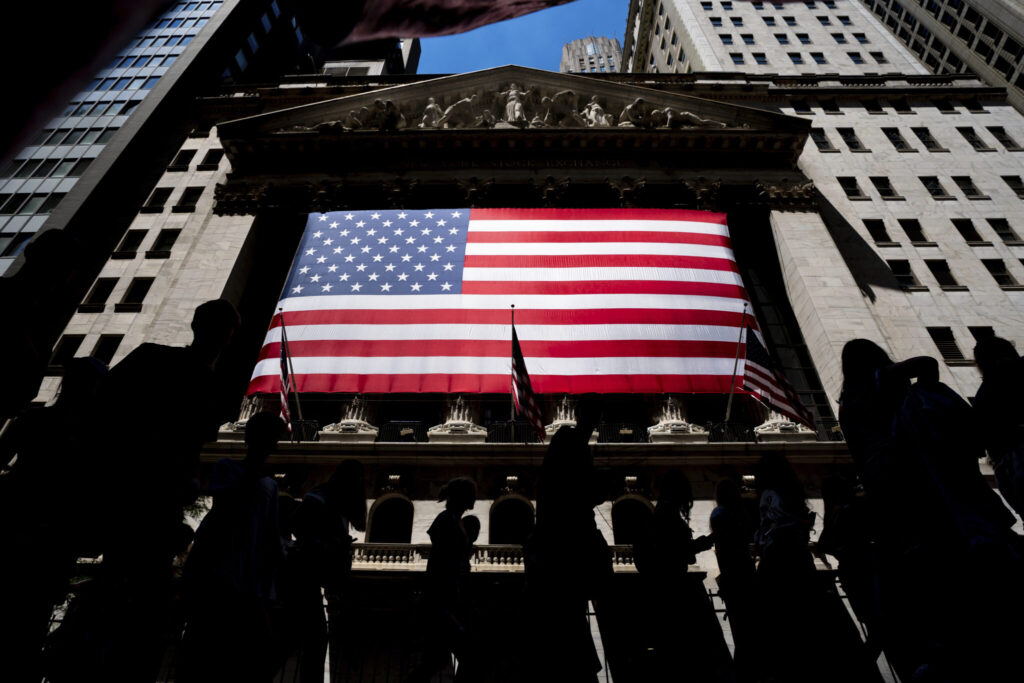Wall Street rose on Friday after data showed the U.S. economy added fewer-than-expected jobs in July, while Amazon’s better-than-expected earnings countered Apple’s tepid sales forecast. Nonfarm payrolls increased by 187,000 jobs last month, Labor Department data showed. Data for June was revised lower to 185,000 jobs added instead of the previously reported 209,000. Average hourly earnings grew 0.4% in July, unchanged from the previous month but a tad higher than expectations, spurring worries of more interest rate hikes before the end of 2023. That kept the year-on-year increase in wages at 4.4%. The Associated Press has the story:
Wall Street rises following US job reports, Tech earnings data
Newslooks- NEW YORK (AP)
Stocks are drifting higher Friday following mixed reports about the U.S. job market and profits at two of Wall Street’s most influential stocks.
The S&P 500 was 0.5% higher in early trading and heading for its first gain in four days. The Dow Jones Industrial Average was up 171 points, or 0.5%, at 35,387, as of 9:45 a.m. Eastern time, and the Nasdaq composite was 0.5% higher.
Taking some pressure off stocks were falling Treasury yields in the bond market. They dipped after a highly anticipated U.S. jobs report said hiring was a touch weaker last month than economists expected, though wages for workers rose more than forecast.
The job market is in a precarious place, where investors want a reading that’s neither too hot nor too cold. On one hand, investors want it to remain strong enough to keep the economy out of a long-predicted recession. On the other, they don’t want wage growth in particular to be so strong that the Federal Reserve sees it putting upward pressure on inflation.
Friday’s reading offered no slam dunks for either side, but analysts said it suggests a job market that’s moderating.
“Over the last year the labor market has shifted from one where everyone wins to one where there are plenty of areas of weakness,” said Brian Jacobsen, chief economist at Annex Wealth Management. “Wage growth was stronger than expected, but coupled with a shorter workweek you get lower incomes. Fed officials will see what they want to see, but it’s pretty clear that manufacturing is struggling and services is slowing.”
If the job market keeps moderating, it could allow inflation to continue to cool from its peak reached last summer. That in turn would bolster Wall Street’s hopes that the Federal Reserve won’t hike interest rates any more.
High rates work to grind down inflation by slowing the overall economy and hurting prices for investments. The Fed has already pulled its federal funds rate to its highest level in more than two decades, up from virtually zero early last year.
Critics, though, say it’s far from assured that inflation will easily drop back down to the Fed’s target and that the economy will avoid a painful recession. That’s why they say the 19.5% surge for the S&P 500 through this year’s first seven months was too much, too fast. This week, the S&P 500 is on track for its first losing week in the last four.
Big Tech stocks in particular led Wall Street’s charge this year, with expectations for strong continued growth leading to tremendous gains in their stock prices. Two of them offered a mixed picture of their results after trading ended Thursday.
Amazon jumped 9.3% in its first trading after it reported a much bigger profit for the spring than expected. The company said growth for its important cloud-computing business stabilized during the quarter, and its revenue also topped analysts’ forecasts.
Apple, though, slumped 2.3% despite also reporting stronger profit than expected. Its revenue only just barely topped analysts’ estimates, and its forecast for revenue in the current quarter didn’t blow past expectations.
Its stock had already cruised 47% higher for the year through Thursday, meaning high expectations were built into its price.
Because it’s the biggest stock on Wall Street by market value, Apple’s movements pack extra punch on the S&P 500 and other indexes. It was the single biggest weight on the S&P 500.
In the bond market, the yield on the 10-year Treasury fell to 4.11% from 4.18% late Thursday. It helps set rates for mortgages and other important loans.
The two-year Treasury yield, which moves more on expectations for the Fed, fell to 4.81% from 4.89%.
In stock markets abroad, indexes were mixed across Europe and Asia.







